8
Disarming
Enter the premises through the designated Entry-Exit door. The keypad will be sounding a tone to indicate that
the system must be disarmed. Go to the keypad and enter an Access Code. If an error is made entering the
code, press the [#] Key and enter the code again. The “Armed” light will be shut OFF and the keypad sounder
will be silenced. An Access Code must be entered before the Entry Delay expires or an alarm will sound. To
change the Entry Delay, refer to Programming Section [02].
If an alarm occurred while the system was armed, the “System” light and the zone lights of the zones that went
into alarm will FLASH for two minutes. Press the [#] Key to cancel the flashing display and to return the system
to the “Ready” mode. Refer to [
∗
][3]: Alarm Memory Display.
Important Note about Keypad [
∗
] Commands
The [
∗
] commands will not function when the bell or siren is active. In order to use the [
∗
] functions, an Access
Code must first be entered to silence the alarm.
[
∗
]+[0]: Quick-Arm
The Quick-Arm feature allows a user to enter [
∗
][0] to arm the system. This command is designed to allow
someone to arm the system without that person having to be provided with an Access Code. When [
∗
][0] is
entered, the Exit Delay will begin and the user may exit the premises through the Entry/Exit door. At the end
of the Exit Delay, the system will be fully armed; activating any zone will cause an alarm.
[
∗
]+[1]+[Access Code]: Zone Bypassing
A bypassed zone will not cause an alarm. Use zone bypassing when access is needed to part of a protected
area when the system is armed, or if damage to sensors or wiring cannot be repaired immediately. The system
may be armed with one or more zones bypassed even if the zones are open.
With the system disarmed, enter [
∗
][1][Access Code] to display the bypassed zones; the zone lights of
bypassed zones will come ON. Ensure that any zone displayed as being bypassed is intentionally bypassed.
Zone bypasses are automatically cancelled when the system is disarmed.
To Bypass Zones:
Enter [
∗
][1][Access Code]; the “System” light will FLASH. Enter the number of the zone
to be bypassed; the corresponding zone light will come ON to indicate that the zone is bypassed. To remove
a bypass, enter the zone number and its zone light will be shut OFF. When all desired zones are bypassed,
press the [#] Key to return to “Ready”.
[
∗
]+[2]: Display Trouble Conditions
The PC560 continuously monitors a number of trouble conditions. If one of these conditions occurs, the keypad
“System” light will come ON and the sounder will sound two short beeps every 10 seconds. To silence the
sounder, press the [#] Key; the sounder will be silenced but the “System” light will remain ON until the trouble
condition is cleared. Refer to Programming Section [13] Maintenance Codes for a list of trouble conditions that
can be reported to the monitoring station.
To display trouble conditions, enter [
∗
][2]. Trouble conditions are represented with the zone lights:
Zone Light
1 Battery Trouble.
If the battery is disconnected, its voltage is low or the battery fuse is open, a
trouble will be displayed and can be reported.
2 AC Failure.
If AC power is removed from the system, an AC trouble will be displayed.
3 Tamper Zone. Zone Light 3 will come ON when the Tamper Zone is activated and will remain
ON until the zone is restored. NOTE: The system cannot be armed until the Tamper Zone is
restored.
4 Unsuccessful Communication Attempt. If the digital communicator cannot communicate with
the monitoring station after 8 attempts, a trouble is generated. If a later attempt at communication
is successful, the trouble is cleared. The trouble can also be cleared by pressing the [#] Key to
exit from the Display Trouble Conditions mode.
17
[13] Maintenance and Priority Codes
Maintenance Codes are transmitted to indicate various trouble conditions and their restorals; Priority Codes
are used to indicate the activation of the [F], [A] and [P] keys. Program a 2-digit code for each of the following
conditions:
• Battery Trouble • [P] Key alarm • [P] Key restore • Police Code
• Battery Trouble Restore • [A] Key alarm • [A] Key restore
• Periodic Test Code • [F] Key alarm • [F] Key restore
The Periodic Test Code is transmitted to the monitoring station once every 24 hours. The first transmission will
be sent 12 hours after the system is first powered, and then once every 24 hours after the initial transmission.
If the Police Code is programmed it will be transmitted to the monitoring station if two or more alarms occur on
different zones during the same armed period. The Police Code will be sent immediately after the transmission
of the second alarm code.
[14] Downloading Access Code
This 4-digit code allows the system to confirm that it is communicating with a valid downloading computer. Enter
a 4-digit code using the numbers 0 through 9; the hexadecimal numbers A through F may also be used in this
code. The default code is [0505].

